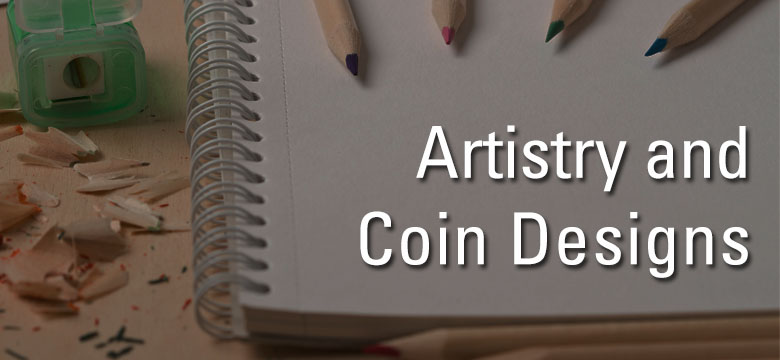
From the earliest beginnings of the U.S. Mint in the 1790s until the early 1900s, designs for American coinage were not typically produced by outside artists. Instead, the images displayed on our nickels, cents, gold coins, and more tended to be produced in a relatively insular manner by a small group of in-house designers at the Mint. With this in mind, practical matters in design often took the place of novel ideas or artistic liberty. Although many early designs are considered attractive by the numismatists that collect them, it was not until President Theodore Roosevelt called for radical changes in our nation’s coinage that a new era of true artistry and aesthetic exploration in numismatics began.
Convinced that the circulating coinage of the early 1900s was uninspired and perhaps even unattractive, President Roosevelt called for a “renaissance” in American coinage that has since been the subject of entire books and articles. He is famously quoted as having written that “our coinage is artistically of atrocious hideousness.” The President’s harsh criticism started a firestorm of activity, beginning with bills allowing for the creation of new coin designs by outside artists, external to the U.S. Mint.
 Augustus Saint-Gaudens, a renowned sculptor, was chosen for this new series of designs that began to be produced in the 1907. Revitalizing the $10 and $20 gold denominations, Saint-Gaudens produced designs that have remained popular ever since. In fact, his $20 design has been so enduringly popular that $20 Saint Gaudens coins carry his name today among numismatists. In addition, his design was chosen to be replicated on the American Gold Eagle bullion coins that have been produced since 1986.
Augustus Saint-Gaudens, a renowned sculptor, was chosen for this new series of designs that began to be produced in the 1907. Revitalizing the $10 and $20 gold denominations, Saint-Gaudens produced designs that have remained popular ever since. In fact, his $20 design has been so enduringly popular that $20 Saint Gaudens coins carry his name today among numismatists. In addition, his design was chosen to be replicated on the American Gold Eagle bullion coins that have been produced since 1986.
This was not all, however. The radical change in thinking that allowed Saint-Gaudens to redesign the $20 gold piece opened up new possibilities for other artists, who were involved with several additional revitalized series of coins.
Next to be adopted were the $2 ½ and $5 gold denominations, both of which were boldly overhauled from the traditional and allegorical bust of Liberty to a new, incuse design of a Native American that has earned these coins the nickname of $2 ½ and $5 Indians. Bela Lyon Pratt, who served as Saint-Gaudens’ assistant while an art student in New York, was chosen by Theodore Roosevelt to design these two denominations on recommendation of his friend Dr. William Sturgis Bigelow, a patron of the arts and prominent physician. Like his mentor Saint-Gaudens’ $10 Indian design, Pratt’s $2 ½ and $5 Indian coins depicted a Native American on the obverse and a bold eagle on the reverse.
Perhaps the most radical feature of Pratt’s design for these two denominations was the incuse design, where the devices of the coin were sunk below the coin’s surfaces to create a flat plane suitable for stacking coins. Although incuse designs existed among ancient coins, this was the first example of such a design in the realm of American coinage, and this dramatic change resulted in significant attention at the time of minting in 1908.
Next, when the nickel was to be redesigned a few years later, artist and sculptor James Earl Fraser was chosen to design what was later to become the beloved Buffalo Nickel. This change from the Liberty Nickel design of 1883-1913 was allowed by the Mint Act of September 26, 1890, which included a provision to redesign the 5 cent denomination, as well as other pieces, after an existing design had been used for at least 25 years. The Indian and Buffalo motif which Fraser designed proved quite popular both with Fraser’s contemporaries and throughout the years. The Buffalo Nickel was first minted in 1913 and, like the $20 Saint-Gaudens, retained such  popularity that the design was resurrected years later for use on a modern gold bullion coin.
popularity that the design was resurrected years later for use on a modern gold bullion coin.
Although there are additional artists and politicians who have since influenced the infusion of creativity and artistic talent which now characterizes the U.S. Mint, these examples are representative of the radical transformation that occurred at the suggestion of President Roosevelt. Although he did not live long enough to fully enjoy the fruits of his labor, the effects of this bold program of artistry in coinage can be seen and enjoyed even today.
By Sarah Miller


I got an jeton( I guess) and I wonder if you can tell me anything about it. How old or where it might come from the beginning. Can I send you a picture of it. Maybe a collector do know anything about it. I have never seen any coin like this. /Eva Pedersen, Sweden
Hi Eva, thank you for contacting us! We would be more than happy to assist. One of our experts would be able to help with the evaluation process. We offer free auction evaluations online at our website. You can simply click the link:https://www.ha.com/c/acquisitions.zx?target=auctionevaluation&type=kk-fb-cs-freeeval-07071 and it will redirect you to a form submission page where you will be able to submit pictures and a brief description. If you have any questions or would like immediate assistance please contact our Client Services department at 1-866-835-3243 or email bid@ha.com Thank you!